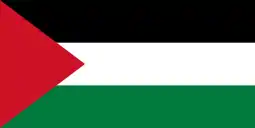Jahalin Bedouin
The Jahalin Bedouin are a Palestinian tribe who currently live in the Palestinian desert of the West Bank and historically inhabited the area around Tel Arad and Ein Gedi.

| Part of a series on |
| Palestinians |
|---|
 |
| Demographics |
| Politics |
|
| Religion / religious sites |
| Culture |
| List of Palestinians |
History
In March 1875 Claude R. Conder, leader of the Palestine Exploration Fund survey team, reported the land south of Ain Jidy, close to Masada, belonged to the Jahalin. He met one of their sheikhs, Abu Dahuk, and noted the size and strength of their horses and their fondness for tobacco. He states that they had recently been driven from their country by Dhullam Arabs and mentions a war going on three hours from the team's camp at Beit Jibrin.[1] Earlier in the same year one of Conder's colleagues on the survey listed the Jahalin as numbering 150 men, with 100 tents.[2]
The Jahalin lived in the Tel Arad region of the Negev at the time of the creation of the state of Israel. In 1952, the Jahalin were evicted from their traditional lands by the Israeli army and settled at a location now within the boundaries of Maale Adumim.[3] There, they took up their traditional seminomadic lifestyle, grazing livestock in the nearby area and the Jordan Valley. However, after the 1967 Israeli occupation of the West Bank, access to their grazing grounds was increasingly restricted by the Israeli military.[4]
Today
The tribe currently lives in villages such as ʿArab al-Jahalin, Wadi Abu Hindi, Al Muntar, Al- Hathrura, Ghawaliya, Wadi Sneysel and Khan al-Ahmar east of Jerusalem,[5] bordered by the Israeli settlements of Maale Adumim and Pisgat Ze’ev.[6] On 16 September 2014 it was announced that they would be moved to a new area in the Jordan Valley north of Jericho.[7]
On 17 April 2012 a documentary about the Jahalin, "Nowhere left to go" directed by Harvey Stein, was premiered at the French Cultural Centre, Jerusalem.[8]
Since 2014, a football team made up of Jahalin Bedouin, the Desert Hawks, has been training and competing in the nearby Palestinian city of Bethlehem.[9]
References
- Palestine Exploration Fund Quarterly Statement for 1875. London. Page 132. "we found fully worthy of Dr. Robinson's remark that they are the filthiest and most degraded of Arabs."
-
- Tyrwhitt Drake, C.F. (1875). "Mr Tyrwhitt Drake´s report". Quarterly statement - Palestine Exploration Fund. 7: 28.
- Palestine & Palestinians. Beit Sahour: Alternative Tourism Group. September 2008. p. 162. ISBN 9950-319-01-3.
- "Bedouins around Ma'ale Adumim". B'Tselem. 18 May 2014. Retrieved 7 March 2016.
The members of the tribe were nomadic, roaming in this area and in the Jordan Valley to graze the livestock on which their livelihood depended. After the occupation of the West Bank by Israel in 1967, the Israeli military increasingly restricted the Bedouins’ access to many of the grazing grounds. Little by little, they were forced into the vicinity of the Jerusalem‐Jericho road. There, until the 1980s, the Jahalin Bedouins established semi-permanent encampments, as well as at least two permanent structures.
- Hass, Amira (6 February 2012). "Bedouin Community Wins Reprieve From Forcible Relocation to Jerusalem Garbage Dump" – via Haaretz.
- "Khan al-Ahmar: The human rights impact of Israel's settlement expansion". www.amnesty.org.
- Israeli government plans to forcibly relocate 12,500 Bedouin - Retrieved 16 September 2014
- "The Jahalin Bedouin". The Jahalin Bedouin.
- "The Desert Hawks: Bedouin football team plays against all odds". www.middleeasteye.net.
